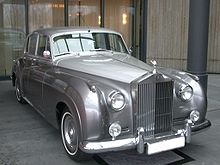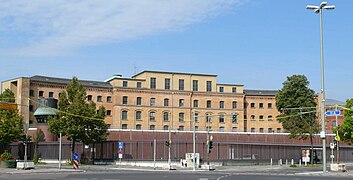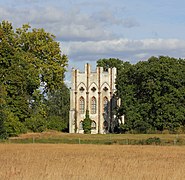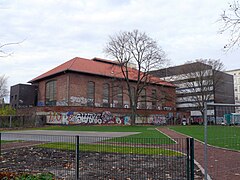The monk with the whip
| Movie | |
|---|---|
| Original title | The monk with the whip |
| Country of production | Federal Republic of Germany |
| original language | German |
| Publishing year | 1967 |
| length | 88 minutes |
| Age rating | FSK 12 |
| Rod | |
| Director | Alfred Vohrer |
| script |
Alex Berg , Harald G. Petersson |
| production |
Rialto Film ( Horst Wendlandt , Preben Philipsen ) |
| music | Martin Böttcher |
| camera | Karl Löb |
| cut | Jutta Hering |
| occupation | |
| |
The Monk with the Whip is a German crime film that was shot in 1967 under the direction of Alfred Vohrer . The color film was the 29th entry in the German Edgar Wallace film series . The work is only based on motifs by Edgar Wallace , but ties in with the black and white film The Uncanny Monk from 1965. The monk with the whip was premiered on August 11, 1967 in the Mathäser-Filmpalast in Munich .
action
The scientist Dr. Cabble develops an odorless poison gas on behalf of an unknown person . Winston Robson, Cabble's overly curious assistant, is the first victim of the deadly fabric. After Dr. Cabble his client, who drives a noble Rolls-Royce , hands over the poison and a book prepared with it, he is murdered by a red-clad monk with a whip.
In a London prison is a pickpocket and cheats Frank Keeney moved into the cell of a certain Cress Bartling. Bartling offers Keeney £ 1,000 to do a job outside the prison walls. With the help of jailer Carrington and the kitchen staff, Keeney actually gets outside. On a country road, he is handed over to a man named Greaves, the driver of a Rolls-Royce. This brings Keeney to a dilapidated villa, in which a mysterious man behind resides between crocodiles and aquariums. He hires Keeney to give boarder Pam Walsbury a hymn book in a village church. Little does he know that it has been prepared with the poison gas. When the girl opens the book and dies on the spot, Keeny is taken back to prison.
By chance the police doctor Dr. Shine Wood behind this is that the girl with a poison based on hydrogen cyanide was murdered. Scotland Yard boss Sir John and Inspector Higgins are investigating the case at the girls' boarding school. Its director, Harriet Foster, cannot explain Pam's murder. The teachers Harrison and Brent as well as the pedell Bannister suspect the chemistry teacher Keyston, who had a relationship with Pam. Ann Portland tells officials that some of her classmates, including Pam, occasionally have wild parties. Mr. Keyston and Mark Denver, a boarding school shed writer and brother of Harriet Foster, hosted these parties. During the night the monk in the red robe shows up at the boarding school to take the prepared hymn book from Pam Walsbury's cupboard. Some of the students watch the figure and alert the Scotland Yard officials present. But the monk can escape. As is so often the case, the curious gardener Glenn Powers observes the processes from a safe distance.
The next evening, the student Betty Falks makes the decision to leave the boarding school. Once again, Frank Keeney goes into freedom to fulfill an assignment from the mysterious man behind. On the way to the bus stop, Betty meets the monk with a whip. She escapes to the bus where she is murdered by Keeney with a poison gas pistol. The bus conductor clearly remembers Keeney's face. Inspector Higgins, however, thinks he is innocent, as the man is officially safely behind bars. Keyston confesses to Higgins that he spent twenty years in prison for killing a young girl. The inspector refrains from arresting the teacher. A red monk with a whip kills Keyston that night.
On the evening of the next day, student Mary Houston appears at Mark Denver's summer house. She accuses Denver of being behind the murders because he too had a relationship with Pam and she was expecting a child from him. Betty Falks knew this. After an argument in which Denver becomes intrusive, Mary flees the garden shed. Inspector Higgins, who is also in the garden shed and overheard the conversation, cannot prevent Mary from being murdered with a poison gas pistol in the park. This time the investigator himself recognizes Frank Keeney, who is actually imprisoned, as the perpetrator. Keeney forces the chauffeur Greaves to take him to the old mansion. Keeney tries to confront the man behind him, but is murdered by the monk with a whip. When Higgins appears in prison, he apparently finds Keeney hanged in his cell.
The next day, chemistry teacher Keyston was also found hanged under the boarding school's swimming pool. The mysterious man behind the scenes orders Cress Bartling to murder the schoolgirl Ann Portland that night. Inspector Higgins discovers that Ann is the sole heir to the Portland Aircraft Plant. That same night, Higgins sneaks into the boarding school in the disguise of the red monk and fakes an alleged kidnapping of Ann Portland and escapes with her in his car. He brings her to safety and thus thwarted an assassination attempt by Bartling. Meanwhile, the shady Mark Denver is murdered by the red monk.
Bartling and Greaves kidnap Ann Portland from her hiding place in a sand pit. Sergeant Hanfield, disguised as a prison chaplain, tells the yard officials how Keeney and Bartling were able to leave the penitentiary. Inspector Higgins is able to reconstruct the escape route and arrives with Sir John at the mysterious villa to which Ann has been dragged. Boarding school director Harriet Foster and the gardener Glenn Powers, who follows her, are also on their way there. In the villa Powers is already expected by the monk, who wants to kill him with the whip. Powers can shoot him if necessary. A short time later, Sir John and Higgins arrive. When Powers lifts the monk's red mask, Harriet Foster is underneath. Powers tells investigators that Mrs. Foster is his wife. Both worked in a circus, where Harriet galloped on horseback and whipped glasses off the table. After she left him, Powers discovered that his wife was now insane and under the influence of a mysterious backer. Then the pedell Bannister appears, whom Higgins exposes as Ann's uncle Limes Portland. In the event of Ann's death, he would have inherited her late parents' aircraft factories. To draw attention to others, he had first murdered the girls Pam Walsbury, Betty Falks and Mary Houston.
History of origin
Background and script
The Edgar Wallace film The Eerie Monk , launched in December 1965, had developed into a great success for the production company Rialto Film and the distributor Constantin Film , which saw around 2.5 million cinema-goers during its premiere. As a result, the Rialto boss Horst Wendlandt definitely wanted to make a second film in which a murdering monk appears with a whip. Harald G. Petersson was commissioned to write a corresponding screenplay based on the Edgar Wallace novel Gucumatz (original title: The Feathered Serpent ). At the beginning of 1967 Herbert Reinecker (pseudonym: Alex Berg ) rewrote this script with the title The Man with the Whip , so that practically nothing was left of the novel. Then the director Alfred Vohrer , who was to direct his 10th Edgar Wallace film, made some additions and changes to the script as usual. Among the most important are the moving of Pam Walsbury's murder from a park to a village church and the omission of a police psychologist named Donald Blake in favor of an expansion of the character of Sir John. In addition, the project received its final title: The Monk with the Whip .
occupation
A first announcement saw the originally planned director Harald Reinl, the actors Harald Leipnitz as Inspector Green, Karin Baal as Ann Portland, Siegfried Schürenberg as Sir John, Claude Farell as Harriet Foster, Wolfgang Lukschy as Mark Denver, Harry Wüstenhagen as Frank Keeney and Grit Boettcher and Rudolf Fernau . The planned start date was August 30, 1967.
With the exception of Siegfried Schürenberg and Grit Boettcher, all roles were ultimately cast with other actors. As it was the first time since 1964 that Joachim Fuchsberger could be engaged as a Wallace inspector, the role of the investigator was finally renamed Inspector Higgins. He embodied this in the hit film The Witcher . For the role of Ann Portland, they went back to Uschi Glas , who made her film debut in The Unheimliche Mönch and was now under contract with Wendlandt. In addition to actors such as Harry Riebauer , Ilse Pagé , Claus Holm , Hans Epskamp , Kurt Waitzmann , Tilo von Berlepsch and Rudolf Schündler , Tilly Lauenstein , Konrad Georg and Günter Meisner were engaged for one-off guest appearances . The actors Siegfried Rauch and Narcissus Sokatscheff later appeared in another Wallace film.
Inge Sievers , the then wife of Werner Schröder - the boss of the Berlin aquarium, in which some scenes were shot - can be seen in a supporting role as boarding school student Mildred Miller. The manager Herbert Kerz was the double for the monk with the whip. Film architect Wilhelm Vorwerg appeared as the second murder victim Dr. Cabble. The assistant director Eva Ebner took on an extra role in the scene with the bus. The voice of director Alfred Vohrer can be heard several times on the radio.
production
Filming for the wide screen format 1: 1.66 produced color film (Eastman Color) found immediately after the completion of its predecessor , the blue hand of 30 shooting days between 26 April and 9 June 1967 in West Berlin instead. This time, too, no London recordings were made at all. The following locations can be seen in The Monk with the Whip :
- Horse stable on Pfaueninsel : cemetery, murder of Dr. Cabble
- Prison Moabit : penitentiary, outside and inside
- Villa Lohse (Inselstraße 30, demolished in 1975) on Schwanenwerder : dilapidated villa, outside
- Aquarium Berlin : dilapidated villa, inside
- Meierei on Pfaueninsel: village church, outside
- Church of St. Peter and Paul on Nikolskoe : village church, inside
- Kavaliershaus on Pfaueninsel: girls' boarding school, outside
- Stadtbad Wedding : swimming pool of the girls' boarding school, inside
- Sand pit in hunting 86 in the Grunewald : Sand pit
The two short shots with the snakes are from the movie The Blue Hand . The CCC-Film studios in Berlin-Haselhorst served as the film studio . The film structures came from Wilhelm Vorwerg and Walter Kutz . Irms Pauli was responsible for the costumes . Production manager was Fritz Klotzsch . The production line took Wolfgang Kühnlenz , the assistant director Eva Ebner.
- Filming locations in Berlin
Film music
The soundtrack was penned by Martin Böttcher , who composed his fifth and final soundtrack for an Edgar Wallace film for The Monk with the Whip . Three tracks from it were published in 1999 on the CD Martin Böttcher - Kriminalfilmmusik Vol. 2 :
- Terrible (theme music) 1:58
- Blue Trombone 1:07
- Nightwalk - Final 2:01
The title music Terrible is also included on the CD Martin Böttcher - German Film Composers Episode 1 from 2000 and on the 2002 compilation The Best of Edgar Wallace .
reception
Publications
The film was released on August 4, 1967 by the FSK without any restrictions on age 16 and over. On August 11th of the same year the premiere took place in the Mathäser-Filmpalast in Munich . Although the success lagged behind that of the film The Uncanny Monk , it was still more than satisfactory with around 1.8 million viewers during the premiere time. In the polls carried out by the trade journal Filmecho / Filmwoche at the time , in which cinema visitors rated current films on a scale from 1 (excellent) to 7 (very bad), The Monk with the Whip received a grade of 2.4. For comparison: The films The Blue Hand (2.4), Commissioner X - Three Green Dogs (2.7) and The Snake Pit and the Pendulum (3.2), also published in 1967 .
The film could be marketed in other countries and ran there under the following titles:
- Denmark : Varme piger gøres kolde
- Finland : Koulutyttömurhat
- Greece : O dolofonos tou parthenagogeiou
- Italy : Il fantasma di Londra
- Turkey : Kiz kolejinde cinayet
- United States : The College Girl Murders
The film was first broadcast on German television on April 11, 1985 on the Sat.1 predecessor PKS. For publication as a purchase video, the age rating was downgraded from 16 to 12 years in 1991. The original version of the film was released on DVD in 2004 . This was also released from the age of 12.
Reviews
“Director Alfred Vohrer has made better films than this one. Here the worn-out clothes of the kintop are scraped together and puffed up in bad colors. Neither tension nor horror mood really want to arise. Everything is told too cumbersome, clumsy and implausible. "
"If you want to be chased in the fenugreek for 90 minutes, this exciting product is recommended."
"Since the Edgar Wallace films were shot in color, the quality of their craftsmanship has increased significantly."
“Extremely confused and amateurish Edgar Wallace film. Remake of "The Scary Monk". "
“The uncanny monk” ('65) was in black and white. The remake is in Eastman color, but dramaturgically is rather colorless. "
"Horror, thriller and parody in one."
“Edgar Wallace crime thriller, cinema-style; a mix of styles of crime fighter, horror shocker and parody of both. "
"An unimaginative and tension-free staged crime scene that makes a fool of itself."
Others
Contrary to the first script, which describes the monk all in black with a white cord, the costume designer Irms Pauli created a striking red costume, the headgear of which is reminiscent of that of the Ku Klux Klan . The figure is still one of the most famous of the Edgar Wallace film series. So she appeared as the first fatality in the Wallace parody The Wixxer (2004).
literature
- Joachim Kramp , Jürgen Wehnert: The Edgar Wallace Lexicon. Life, work, films. It is impossible not to be captivated by Edgar Wallace! Verlag Schwarzkopf & Schwarzkopf, Berlin 2004, ISBN 3-89602-508-2 .
- Joachim Kramp: Hello! This is Edgar Wallace speaking. The story of the legendary German crime film series from 1959–1972. 3. Edition. Verlag Schwarzkopf & Schwarzkopf, Berlin 2005, ISBN 3-89602-645-3 .
Web links
- The monk with the whip in the Internet Movie Database (English)
- The monk with the whip at filmportal.de
- The monk with the whip ( memento from December 26, 2007 in the Internet Archive ) at deutscher-tonfilm.de
- Sound carrier with the film music
Individual evidence
- ↑ 88 minutes for cinema projection (24 images / second), 84 minutes for television playback (25 images / second), film length: 2397 meters
- ↑ a b Joachim Kramp and Jürgen Wehnert: The Edgar Wallace Lexicon. Life - work - films . Schwarzkopf & Schwarzkopf, Berlin 2004, ISBN 3-89602-508-2 , p. 97 .
- ↑ Joachim Kramp: Hello! This is Edgar Wallace speaking. The history of the crime film series from 1959 to 1972. Third, revised and expanded edition . Schwarzkopf & Schwarzkopf, Berlin 2005, ISBN 3-89602-645-3 , p. 325-335 .
- ↑ What was that probably? A small addendum to the history of our neighboring island Schwanenwerder […] In: BYC-Aktuell. Membership newspaper Berliner Yacht-Club. Berliner Yacht-Club , March 2009, p. 56 , accessed on May 14, 2020 .
- ↑ Martin Böttcher: Kriminalfilmmusik Vol. 2. BSC Music. 1999. Order no. 398.6534.2
- ^ Martin Böttcher: German film composers, episode 1. Bear Family Records . 2000. Order no. BCD 16481 AR.
- ^ The Best of Edgar Wallace. All Score Media. 2002. Order no. ASM 005.
- ↑ The monk with the whip. In: Lexicon of International Films . Film service , accessed June 25, 2017 .










